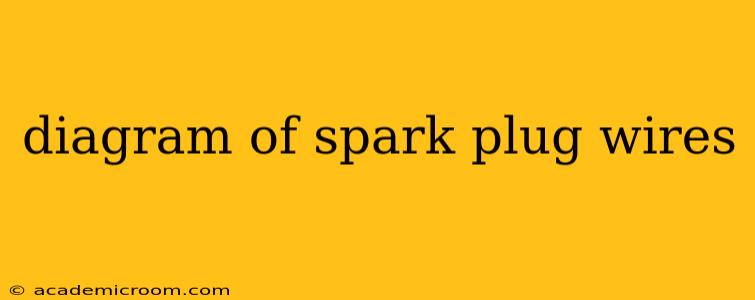Spark plug wires, also known as ignition cables or leads, are crucial components of your vehicle's ignition system. They transmit high-voltage electricity from the ignition coil to the spark plugs, igniting the air-fuel mixture in your engine's cylinders. Understanding their arrangement is essential for proper engine function and troubleshooting. This guide will help you understand spark plug wire diagrams and their importance.
What Does a Spark Plug Wire Diagram Show?
A spark plug wire diagram illustrates the precise firing order of your engine's cylinders and how the spark plug wires connect to both the distributor (in older vehicles) or the ignition coil (in most modern vehicles) and the spark plugs themselves. It's a visual representation of the electrical pathway that ignites the fuel-air mixture in each cylinder in the correct sequence. This sequence is critical for smooth engine operation and optimal performance.
Why is the Firing Order Important?
The firing order dictates the precise sequence in which each cylinder ignites. A mismatched or incorrect wiring sequence can lead to:
- Rough idling: The engine may run unevenly or stall.
- Reduced power: The engine may lack power and acceleration.
- Misfires: Cylinders may fail to ignite consistently, leading to poor fuel economy and potential engine damage.
- Backfires: The unburnt fuel-air mixture may ignite prematurely in the exhaust system, producing a loud backfire.
Each engine has a specific firing order, determined by the engine's design and the arrangement of its cylinders. This information is usually found in your vehicle's owner's manual or online repair databases specific to your vehicle's make, model, and year.
How to Read a Spark Plug Wire Diagram
Spark plug wire diagrams typically show:
- Cylinder Numbers: Each cylinder is numbered, usually starting from the front of the engine.
- Spark Plug Locations: The diagram shows where each spark plug is located within the engine.
- Firing Order Sequence: Numbers or arrows indicate the sequence in which the cylinders fire. For example, a firing order of 1-3-4-2 means cylinder 1 fires first, followed by cylinder 3, then 4, and finally 2.
- Wire Routing: The diagram might show the optimal path for routing the wires to avoid interference and potential electrical issues.
Many diagrams use color-coding to distinguish different cylinders. This color-coding usually aligns with the color of the spark plug wires themselves.
Where Can I Find a Spark Plug Wire Diagram for My Car?
Several resources can provide you with the correct spark plug wire diagram for your specific vehicle:
- Your Owner's Manual: The most reliable source.
- Online Repair Manuals: Websites like Chilton and Haynes offer comprehensive repair manuals for various vehicles.
- Vehicle Repair Databases: Online databases like AllDataDIY often contain detailed diagrams and specifications for different makes and models.
- Auto Parts Stores: Many auto parts stores have access to online databases or printed manuals that can help you identify the correct diagram.
What if My Spark Plug Wires are Damaged?
Damaged spark plug wires can lead to misfires, poor engine performance, and even engine damage. Look for signs of damage such as:
- Cracks or cuts in the insulation: This allows for electrical leakage and misfires.
- Worn or frayed ends: This can lead to poor connections and inconsistent sparking.
- Loose or corroded connectors: Ensure the connectors are securely attached at both the coil and spark plug ends.
If you suspect damage, replace the affected wires immediately with wires that match the specifications for your vehicle. Using incorrect wires can lead to serious engine problems.
How Often Should I Replace Spark Plug Wires?
The lifespan of spark plug wires varies depending on the quality of the wires and the operating conditions of your vehicle. However, it's generally recommended to inspect them every 30,000 to 60,000 miles or every 2-4 years. Replace them if you find any signs of damage.
This guide provides a comprehensive understanding of spark plug wire diagrams and their importance in maintaining your vehicle's performance. Remember, always consult your vehicle's owner's manual or a reliable repair resource for specific information regarding your car's ignition system.
